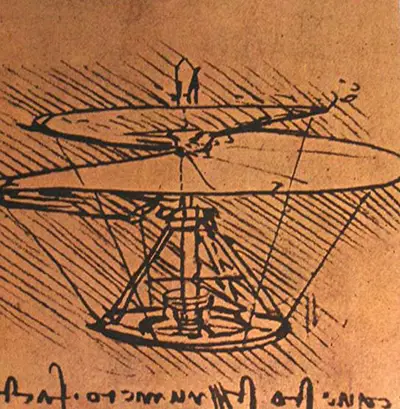As with many of Da Vinci's technical drawings, the plans have been endlessly looked over, discussed and reinterpreted by modern observers, many of whom are keen to show that Da Vinci's plans pre-empted the invention of many modern tools.
The Air Screw isn't the first historical example of a device designed to allow humans to fly. Achieving flight has been a goal of humans for thousands of years and the ancient Chinese are known to have produced plans for devices which are aesthetically similar to the modern day hot air balloon. Da Vinci's design is notable because it does not include any bird like features, which were commonly seen in early flying machine designs.
Da Vinci's Helicopter, also known as the Aerial Screw measured around 15 feet in diameter and was to have been constructed from linen, reed and wire. There is no sign that Da Vinci ever made any efforts to actually push ahead with the construction of a device. However, he clearly spent a lot of time thinking through the practicalities of building it.
Beside the sketches, the artist has scribbled "If this instrument made with a screw be well made – that is to say, made of linen of which the pores are stopped up with starch and be turned swiftly, the said screw will make its spiral in the air and it will rise high". This note is what many modern thinkers have clung to in their attempts to give Da Vinci the credit for the original idea of the helicopter. However, the device he has drawn and described appears to be more similar to a modern microlight.
The screw shape, which was an integral part of what Da Vinci described as an air screw also plays a part in many of Da Vinci's other sketches and inventions. Some have speculated that this comes from the large number of natural, botanical and landscape drawings that the artist produced during his lifetime.
As previously noted, Da Vinci did not appear to make any attempt to produce one of these 'aerial screws' so it is difficult to know whether he would have succeeded had he attempted to. It is not clear that the science and technology of Renaissance Europe would have been able to put Da Vinci's ideas into practice.
Da Vinci's plans for a helicopter are a fascinating example of the artist's side ranging talents and thoughts and an exceptional historical 'what if' question. However, Da Vinci's usual habit of not pursuing his plans and inventions beyond the stage of a sketch mean that we have little idea of how practical the suggestion actually was during his lifetime.


